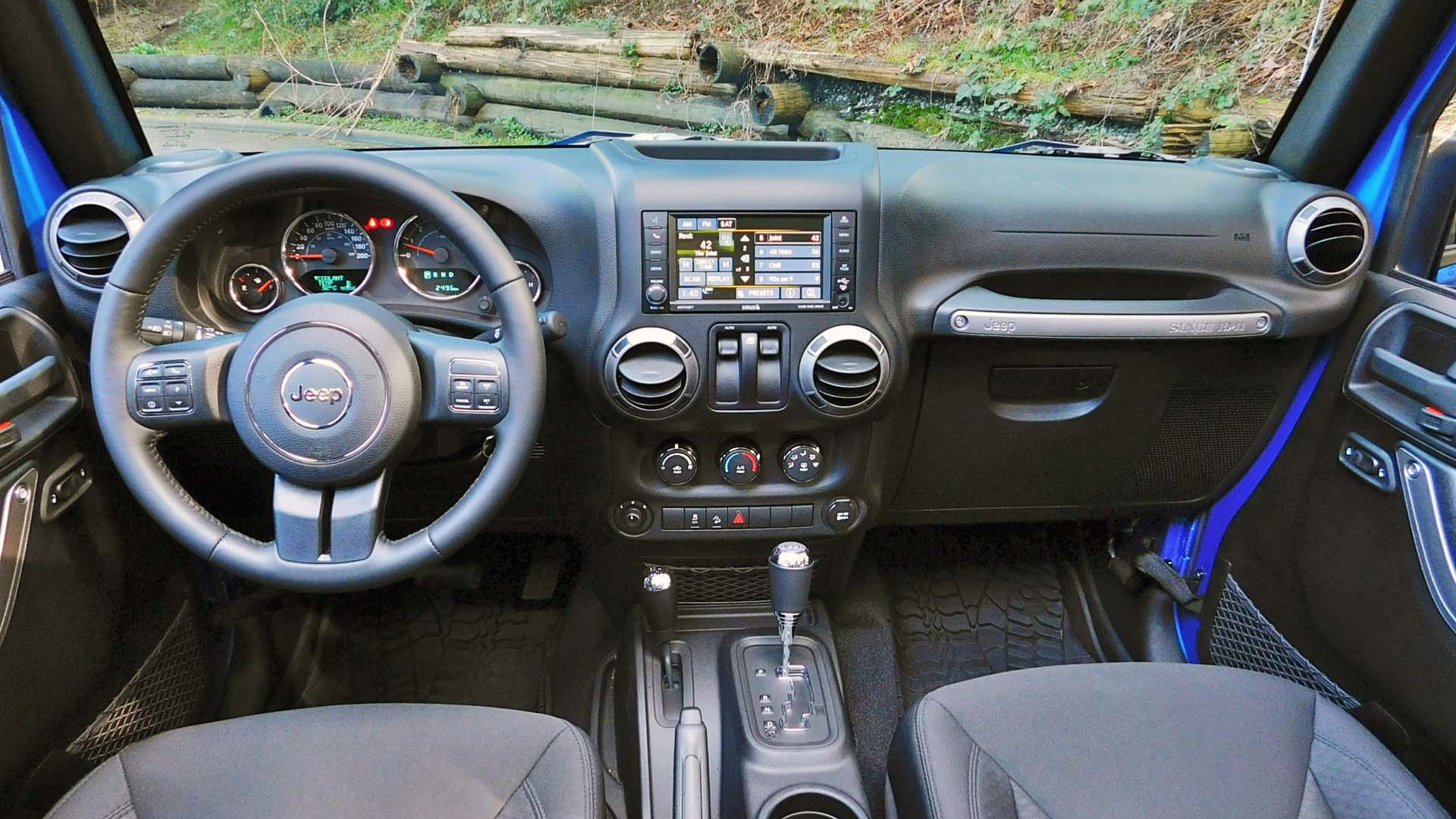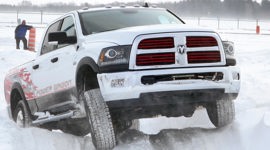 AutoTrader SCORE
AutoTrader SCORE
-
INTERIOR7/10
-
EXTERIOR STYLING8/10
-
FUEL ECONOMY5/10
-
PERFORMANCE8/10
-
COMFORT7/10
Jeep's advertising often boasts that driving one of their vehicles will allow you to get out there and commune more closely with nature. A recent television spot for the Cherokee hints that even in the city, driving a Jeep might mean an unexpected encounter with a pair of friendly-looking wolves. And while much car advertising is pure hyperbole and fantasy, in Jeep's case – certainly in a soft-top Wrangler Sport – it turns out to be the straight-up truth.
I sat there with reggae music blasting and the heat cranked way up, communing with nature's chilly winter interlude and pretending it was a brief tropical shower.
I say this because 15 minutes after picking up my 2016 Wrangler Sport test vehicle in sunny Richmond, where I took a few minutes to lower the rather complicated soft-top, I was sitting in traffic on Oak Street in Vancouver with pellets of nature's wet, icy sleet smacking me in the face and melting down the back of my neck. Raising the top wasn't really an option, since it's a five-minute operation. So I sat there with reggae music blasting and the heat cranked way up, communing with nature's chilly winter interlude and pretending it was a brief tropical shower.
The Jeep Wrangler Sport (the Sport being the iconic short wheelbase two-door, with the Unlimited being the long wheelbase four-door) carries into 2016 essentially unchanged from 2015, with revisions limited to some paint colour changes (Hypergreen and Mojave Sand debut while Baja Yellow, Sunset Orange and Copper Brown are history) plus some available special editions (notably the 75th Anniversary Edition).
Actually, the basic formula has remained largely unchanged since the much-loved military 4x4 first began wartime production in 1941. For Jeep aficionados this is a very good thing, and the real die-hards will likely be buying up 2016 models rather than wait for the redesigned 2017 version because, hey, what if Jeep spoils it or dilutes the formula? (Word is there won't be too much water added the Jeep's spirit, however, with the solid front and rear axles, traditional low range-equipped transfer case, steel body-on-frame construction and near-unstoppable off-roading capabilities all present and accounted for in the redesign. The folding windshield is apparently history though, and other tweaks will see the suspension reconfigured for improved highway manners and the underbody reshaped in order to fit Chrysler's eight-speed automatic.)
Making the list: Best Rides for Beach Fun
My test vehicle was a modest Sport S version (one step up from the base Sport model) and it didn't showcase any of the new-for-2016 colours or trims, but it did showcase all the goodness (and, let's face it, quirkiness) the Jeep Wrangler is known for. It's one of the very few true mainstream off-roaders left on the market (there's the Toyota 4Runner, and a few remaining 2015 Nissan Xterras, and after that you step up into more expensive Land Rover and Mercedes G Class territory). It's certainly the only convertible SUV available in North America.
As the most direct descendant of the original Jeep, the Wrangler Sport's strengths are all well-known: It has legendary off-road capabilities, with its short wheelbase, narrow frame and minimal overhangs providing nimble manoeuvrability and ample angles of approach, breakover and departure (its small footprint, tight turning circle and good outward visibility make it a surprisingly good city vehicle, too). It's easily lifted thanks to its solid axles, and easy to modify in various other ways, with a whole range of factory and aftermarket goodies available. It has an abundance of character, timeless style, and is good fun to drive on the road in its own pitching, bobbing, wandering kind of way. As I told one friend, you just need to embrace the idiosyncratic ride, and there's real joy to be found in having diplomatic immunity against things like curbs, large stones, small fallen trees and other pesky things getting in the way of your intended course.
On the other side of the ledger, the Wrangler's weaknesses are equally well known, or at least easy to guess at: It's noisy and as aerodynamic as a brick, with highway manners that can best be described as "busy." Its handling characteristics are succinctly summed up by the sticker on the visor which warns of the Wrangler's "High rollover risk" and says to "Avoid abrupt manoeuvres." It gets marginal crash test ratings, and poor fuel economy: The sole available engine is a smoothly potent 3.6L VVT V6, which produces 285 hp and 260 lb-ft of torque, and gets official ratings of 14.1 / 11.1 L/100 km (city/highway) with the five-speed automatic transmission as fitted to my test car (ratings with the six-speed manual are 14.1 / 11.0 L/100 km). I was able to nearly match the highway number with a best-recorded result of 11.2 L/100 km, but overall I used significantly more than the ratings would suggest, with an average fuel consumption of 17.7 L/100 km by the end of the week (in fairness I did do some off-roading, which is understandably bad for fuel economy).
Perhaps the biggest weakness, from a city-dweller's perspective, is that the soft-top Wrangler Sport offers absolutely no security whatsoever, with nowhere of consequence to stow any valuables (there's a small lockable console bin included as standard equipment). Even with the top up, anybody who can operate a zipper can easily snag whatever they want from inside the vehicle. A friend who owned an older Jeep YJ got around this problem by building a metal half-box that bolted to the cargo compartment floor and interfaced with the rear swing-gate to provide a small but secure trunk, without interfering with the soft-top operation (the trunk could fit a laptop, camera bag and a couple small pieces of soft luggage). It's quite beyond me why, after 75 years, Jeep doesn't offer something similar (if the designers decide to fix this oversight they should give me a call, because I figured out a pretty slick system that would be quick and easy to install and remove, and would pack up into two small flat pieces for storage).
In addition to the console bin there's also a small cubby under the cargo area floor, and for about $300 you can buy a lockable cover for this, but my test vehicle had the optional Alpine Premium Audio system, which fills the cubby with a somewhat redundant subwoofer. I say "somewhat redundant" because the Wrangler Sport is small inside and the other eight speakers already pump out plenty of bass, to the point where I found myself turning using the equalizer to turn the bass way down. I'm a fan of a deep house and other bass-driven music, but in this instance I'd rather skip the subwoofer and have the stowage space. On the other hand I did appreciate the Sirius radio capability provided with the Alpine audio system, because reggae.
Security concerns aside, the Wrangler Sport (which starts at $25,495 not including freight) provides most of the essential comforts and conveniences: The front buckets are supportive and comfortable, with height adjustment for the driver's seat combined with a tilting steering wheel to allow a good fit for most drivers. In the back there's room for a couple of passengers, provided you haven't already popped out the rear seat for added cargo space (it's a bit of a contortion to get into the rear seat mind you, and the seat itself is distinctly flat and upright). The base model gets 16-inch steel wheels, fog lamps, cruise control (with steering wheel mounted cruise and audio controls), temperature and compass display, electronic stability control, skid plates for the fuel tank and transfer case, hill descent control (in automatic models), and Jeep's famous "wash-out" interior with removable carpets and drain plugs.
The Sport S starts at $30,945 and adds 17-inch alloy wheels, air conditioning, leather-wrapped steering wheel, chrome-and-leather gearshift, and Sirius satellite radio, but notably not Bluetooth connectivity, which is a $525 option. From there you can go somewhat crazy, with models tailored either for greater off-road capability (adding things like upgraded axles, lower gear ratios, electronic front sway bar disconnect, rock rails and so on) or greater luxury (adding things like power locks and windows, navigation, heated leather-faced seating with mesh inserts and such).
Having done a limited amount of off-roading in the test car (and a great amount in my friend's old YJ) I should point out her that yes, the Wrangler Sport will carry you far enough into the backwoods that if you do get stuck you'll need to phone an organization with "off road club" or "rescue service" in its name to come and get you unstuck (assuming you still have cell phone coverage where you are). And no, the Jeep Wrangler really doesn't mind getting dirty. But while the interior may be fairly easy to wash out provided you'd remembered to remove the carpets, the outside of the vehicle has enough crevices and crannies that if you try washing it using the old bucket-and-sponge method it'll be wearing mud in its fender seams and running board mounts forever after, like a backwoods badge of honour. To get a Jeep Wrangler truly clean, you need a spray wash.
At the end of the week, despite the rather steep fuel bill and the fact I'd had to take my camera bag with me every time I left the Wrangler Sport unattended, I was a little wistful returning it. If I lived anywhere else but the city – a tropical island say, or on a nice spread of land in BC's expansive interior, a Wrangler Sport would be high on my list of vehicles to own. There's a reason it's still soldiering along in virtually the same form 75 years after it was first introduced, and that's because despite its quirks – or perhaps, more accurately, because of them – it's still thoroughly awesome.
| Warranty: 3 years/60,000 km; 5 years/100,000 km powertrain; 3 years/unlimited distance corrosion perforation; 5 years/100,000 km roadside assistance Competitors: |
| Model Tested | 2016 Jeep Wrangler Sport S |
|---|---|
| Base Price | $30,945 |
| A/C Tax | $100 |
| Destination Fee | $1,745 |
| Price as Tested | $39,335 |
|
Optional Equipment
$6,545 (Automatic transmission $1,495, anti-spin rear differential $525, Connectivity Group $525, Power Convenience Group $1,000, Mopar Black Appearance Group $685, Supplemental side airbags $400, slush mats $50, Premium black Sunrider soft top $395, 6.5-inch touchscreen radio $775, Alpine premium audio system $695)
|
|















































